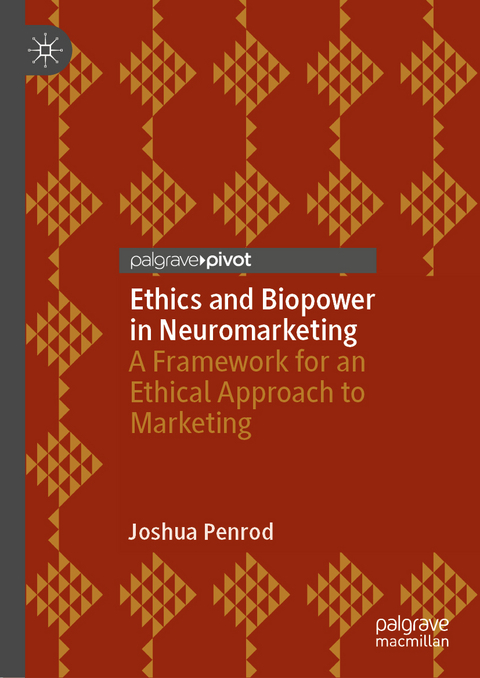
Ethics and Biopower in Neuromarketing
Springer International Publishing (Verlag)
978-3-031-18548-9 (ISBN)
This book explores the ethical and policy implications of the use of neuroscience in marketing. Addressing emerging areas of neuromarketing and consumer neuroscience, this book offers a fresh perspective on establishing a framework for codes of conduct for marketing practices using neuroscientific methods. The use of neuroscience, particularly in commercial and marketing contexts, has been fraught with controversy and ethical concerns. Technological advances have enhanced the ability to not only analyze but also predict (or even control) human behavior.
Using the work of Foucault on biopower, the author discusses the moral dimensions of data collection and observation of consumer behavior in neuromarketing as well as policy implications. After discussing the strengths and weaknesses of various ethical frameworks, the author proposes fixes to current ethical and conduct codes for a more seamless approach for governance. This book advances the scholarship on marketingethics and appeals to researchers of consumer psychology, business ethics, and public policy.lt;p> Joshua Penrod is an adjunct professor in the Department of Marketing and Entrepreneurship, Merrick School of Business at the University of Baltimore, USA. Josh also serves on the senior leadership team of a global trade association, with duties including strategy, marketing, science and technology policy, negotiation, management, and leadership. He earned his Ph.D. from Virginia Tech, USA.
· Chapter One: The Brain and Commerce
o In this opening chapter, I give an overview of the usages of technology for brain scanning and the interpolation of human judgment in interpretation. I also provide a more narrowed description of how these technological artifacts are applied in consumer neuroscience. I summarize the history of the development of this technoscience and its "export" to the commercial world, along with some of the accompanying literature which both advances the claims regarding CNNM and critiques of it. There is an important component of this which is further highlighted: that of the human interpretation of the results, which builds on the work of Dumit and Joyce.
o The editorial "Brainscam" (2004) in Neuroscience is one of the touchstone pieces of critique that spurred neuromarketing research. The piece is frequently cited in both the book-length and peer-reviewed journal literature. It accuses neuroscientists of "jumping on the bandwagon" in an effort to cash in on gullible business executives seeking out the next trend and competitive advantage, even though skepticism and greater caution is warranted. At the same time, there have been advancements of claims regarding the possibilities of CNNM, such as by Renvoise and Lindstrom, claiming high levels of efficacy and going so far as to coin terms, such as the brain's "buy button." This sets the stage for the ethical debate involving CNNM and neuroscience.
· Chapter Two: Business Ethics, Bioethics, and Neuroethics
o This chapter introduces areas of ordinary ethical constructs and their relationships with each other; it undertakes analysis of the ethical concerns with CNNM in the normal contexts. This is a conceptual overview and application of some of the ethical insights regarding specific technologies used in CNNM. In closing, I provide an analysis of the current codes of ethics within the ethical constructs that are typically understood to guide individual and firm actions.
o The area of neuroscience (more generally than CNNM) and its linkage to ethics and policy was thoroughly explored in a special issue of Res Publica (2017). The articles in that issue were fairly diverse, but many of them shared a common thread: an assumption that neuroimaging and related techniques possess, or will possess in the near future, a high amount of efficacy. The assumption manifests itself in several ways, but includes common tropes such as "mind control" and "reading thoughts." Only in this context do the questions posed by the contributors in Res Publica actually seem pertinent, such as normative discussions on the limits to invasions of privacy (including the sanctity of thoughts), policy constraints on incursions into autonomy, and so on. Jesper Ryberg (2015a, 2015b) both creates the context and sets the balls in motion for these discussions within the special issue, authoring the introductory piece and an essay discussing mind reading and mental privacy; this work also provides a springboard for much of the Foucault-oriented analysis contained in the work. Tunick (2015) also registers privacy as the dominant ethical concern in his work. Many of the arguments in the articles in Res Publica are well-reasoned overall, given such an assumptive jump; however, the reality behind the technology associated with CNNM, closely related to many of the discussions currently held in areas of public policy, research subject protections, and evidentiary rules, is that the technologies are just not close to this type of ability. The pervading notion through this strain of literature is that the technology's efficacy is such that such things are now possible, or will be possible next week. While some of the ideas about being able to forecast emotional response are with us now, the specificity and sensitivity of the testing technology has much ground to cover before that efficacy truly exists. As mentioned above as well, the various contributors to the Farah compilation includes analyses of neuroethics as a field separate but stemming from bioethics as a whole.
· Chapter Three: Foucault and Biopower
o This chapter provides an introduction and overview of Foucault's thinking in terms of biopolitics and biopower and the relevance of those concepts to CNNM. It connects the "immanence" of biopolitics with the usage of the technology and its commercial application. In describing and pursuing the analysis, I conceptually expand and extend of Foucault's thinking into the areas of CNNM technoscience. I include several examples of the technologies and analyze them not in the mere ethical constructs used in the previous chapter, but also through deploying I close the chapter by comparing the ethical constructs of Chapter Two and how Foucauldian concepts either supplement or supplant those analyses.
o Levy provides an ethical analysis of some other considerations in neuromarketing in "Neuromarketing: Ethical and Political Challenges" (2009), published in Ethics & Politics. Levy opines that too much focus has been on the internal aspect of ethical considerations when thinking through issues relating to neuromarketing. Behavior, according to Levy, validates neuroscience as much as neuroscience validating findings regarding behavior. Levy urges scholars to not neglect psychological ethics and ethical concerns and that the "internal" aspect of the neuromarketing equation, while important, is not solely determinative of the true dimensions of ethical concern when it comes to neuromarketing.
o Murray et al (2008) in the Journal of Consumer Behavior discusses the neuroethics of neuromarketing by tracing claims of manipulation -overt and covert-over the past several decades. The history begins with the Vicary subliminal experimental claims in the 1950s and the subsequent bestseller by Vance Packard. The authors focus areas of concern mostly on stealth efficacy of manipulation, where a consumer has little or no chance of detecting manipulation by the marketers. They make recommendations of subject and population protections, disclosures, accurate representations, and assurances of internal and external validity of the studies and the practices.
o Foucauldian analysis fits well within the areas of need described by these scholars and adds to the understanding of the special ethical problems surrounding the brain and commerce.
· Chapter Four: Biopower in an Empty Suit
o In this chapter, I provide a realistic assessment of the technoscience and its work, and its true capability. In doing so, the work raises and addresses the questions of power and ethics when technoscience is unsettled, unknown, or frankly non-existent. I assess claims of who is subject to fraud and manipulation and who might be the recipient or victim of the Foucauldian biopower so described earlier. I close the chapter by showing a direction toward development of improved code of ethics for adoption by the professional and commercial community.
o Two chapters from "Neuroethics: An Introduction with Readings," edited by Martha J. Farah warrant special notice. First, Racine et al in fMRI in the Public Eye discuss the discourse using neuro- as a prefix for technologies and its trend in usage in the media. The concern raised in the article is whether there is a disconnect between the expectations of the public and the true probative value of neuroimaging technology (particularly fMRI). The concern is amplified because the authors consider that social expectations can already change and shape policy choices and behaviors ahead of the actual impact of the technology itself. Areas of specific inquiry include the "reality" presented by fMRI, in that "seeing" is an actual reality with greater validity than a behavioral estimation or a surrogate measure; neuroessentialism as a "shortcut" to the equating of the brain to the person (such as in the Pradeep work); and neuropolicy as an area in which usage of an fMRI is advocated on the basis of policy goals, such as the elimination of pornography.
o Tovino describes the arguments behind why neuroimaging must be more tightly regulated and controlled as a matter of non-scientific practice in Regulating Neuroimaging. The argument Tovino makes is that while the technology itself undoubtedly has provided scientific and clinical benefit and improved the lives of many, the concern and fear about improper usage outside of a narrowly-defined scope involving the practice of medicine militates in favor of preventing commercial entities from its usage. She expresses concern about non-experts interpreting the meaning of fMRI, in terms of lie detection and legal discourse, but also in the sense of the possibility of manipulation. Tovino equates discredited practices, such as phrenology, to the over-promising and puffery made by purveyors of neuroimaging's application, certainly in the commercial realm, but also in the judicial and sociological realms as well.
· Chapter Five: Conclusions and next steps
I close the work by recapping and summarizing the arguments contained in the work. I further this by outlining areas of outstanding questions for consideration and resolution. I also propose new directions for the possibility of codes of conduct and ethical use of technologies in CNNM.
| Erscheinungsdatum | 01.11.2022 |
|---|---|
| Zusatzinfo | XI, 167 p. 1 illus. |
| Verlagsort | Cham |
| Sprache | englisch |
| Maße | 148 x 210 mm |
| Gewicht | 365 g |
| Themenwelt | Geisteswissenschaften ► Psychologie ► Arbeits- und Organisationspsychologie |
| Wirtschaft ► Betriebswirtschaft / Management ► Marketing / Vertrieb | |
| Wirtschaft ► Betriebswirtschaft / Management ► Unternehmensführung / Management | |
| Schlagworte | Bioethics • Consumer Behavior • consumer neuroscience • ethics • Foucault • Neuroethics • Neuromarketing |
| ISBN-10 | 3-031-18548-X / 303118548X |
| ISBN-13 | 978-3-031-18548-9 / 9783031185489 |
| Zustand | Neuware |
| Haben Sie eine Frage zum Produkt? |
aus dem Bereich


